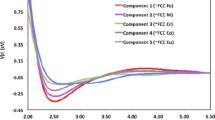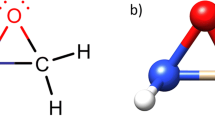Abstract
We report a computational investigation of the electronic and magnetic properties of neutral Tin+1 and FeTin (n = 1–10) clusters using ab initio calculations based on density functional theory (DFT) within the generalized gradient approximation (GGA). The best structures for Tin+1 and FeTin clusters are planar for size n < 5, while from n = 5, they showed a compact three-dimensional cage structure. For the best structures of the FeTin clusters, the Fe atoms favor the peripheral position with the highest coordination with the neighboring Ti atoms. The evolution as a function of the size of the average binding energies (Eb/atom) and HOMO–LUMO gaps of Tin+1 and FeTin (n = 1–10) clusters are studied. The stability results show that the Tin+1 clusters have relatively higher stability than the FeTin cluster with the same size. In addition, the vertical ionization potentials and electron affinities, chemical hardness, and atomic magnetic moment of Tin+1 and FeTin (n = 1–10) clusters are also investigated.











Similar content being viewed by others
Data availability
The datasets generated during the current study are available from the corresponding author on reasonable request.
Code availability
We used the free code SIESTA for all calculations reported in this study.
References
Sun H, Ren Y, Wu Z, Xu N (2015) Density functional calculation of the growth, electronic and bonding properties of titanium clusters Tin (n = 2–20). Comp Theo Chem 1062:74–83. https://doi.org/10.1016/j.comptc.2015.03.021
Sun H, Ren Y, Hao Y, Wu Z, Xu N (2015) The stabilization mechanism of titanium cluster. J Phys Chem Solid 80:105–111. https://doi.org/10.1016/j.jpcs.2015.01.006
Zhao J, Qiu Q, Wang B, Wang B, Wang J, Wang G (2001) Geometric and electronic properties of titanium clusters studied by ultrasoft pseudopotential. Solid State Com 118:157–161. https://doi.org/10.1016/S0038-1098(01)00044-8
Du J, Wang H, Jiang G (2007) Structures of the small Tin (n=2-5) clusters: a DFT study. J Mol Struct: THEOCHEM 817:47–53. https://doi.org/10.1016/j.theochem.2007.04.018
Castro M, Liu S, Zhai HJ, Wang LS (2003) Structural and electronic proprieties of small titanium clusters: a density functional theory and anion photoelectron spectroscopy. J Chem Phys 118:2116–2123. https://doi.org/10.1063/1.1532000
Verkhovtsev AV, Sushko GB, Yakubovich AV, Solov’yov AV (2013) Benchmarking of classical force fields by ab initio calculations of atomic clusters: Ti and Ni–Ti case. Comp Theo Chem 1021:101–108. https://doi.org/10.1016/j.comptc.2013.06.034
Verkhovtsev AV, Hanauske M, Yakubovich AV, Solov’yov AV (2013) Characterization of small pure and Ni-doped titanium clusters: ab initio versus classical approaches. Comp Mat Sci 76:80–88. https://doi.org/10.1016/j.commatsci.2013.03.017
Sun H, Xu N (2016) Structural and magnetic properties of Ti12M clusters (M=Sc to Zn). J Phys Chem Solid 99:92–99. https://doi.org/10.1016/j.jpcs.2016.08.010
Hurtado RB, Cortez-Valadez M, Gámez-Corrales R, Flores-Acosta M (2018) Structural and vibrational properties of gold-doped titanium clusters: a first-principles study. Comp Theo Chem 1124:32–38. https://doi.org/10.1016/j.comptc.2017.12.008
Lian L, Su CX, Armentrout PB (1992) Collision-induced dissociation of Tin-(n=2-22) with Xe: bond energies, geometric structures, and dissociation pathways. J Chem Phys 97:4084–4093. https://doi.org/10.1063/1.463913
Sakurai M, Watanabe K, Sumiyama K, Suzuki KJ (1999) Magic numbers in transition metal (Fe, Ti, Zr, Nb, and Ta) clusters observed by time-of-flight mass spectrometry. J Chem Phys 111:235–244. https://doi.org/10.1063/1.479268
Liu SR, Zhai HJ, Castro M, Wang LS (2003) Photoelectron spectroscopy of Tin- clusters (n = 1–130). J Chem Phys 118:2108–2115. https://doi.org/10.1063/1.1531999
Wu H, Desai SR, Wang LS (1996) Electronic structure of small titanium clusters: emergence and evolution of the 3d band. Phys Rev Lett 76:212–215. https://doi.org/10.1103/PhysRevLett.76.212
Doverstảl M, Karlsson L, Lindgren B, Sassenberg U (1997) The 3Δu−X3Δg band system of jet-cooled Ti2. Chem Phys Lett 270:273–277. https://doi.org/10.1016/S0009-2614(97)00364-3
Sun H, Zhang W, Xu N (2018) Density functional calculation of structural and electronic properties of Tin-xAlx (n =2-8, 13, x=0-n) clusters. J Chem Phys 118:126–136. https://doi.org/10.1016/j.jpcs.2018.01.029
Venkataramanan NS (2008) Structures of small NixTiy (x + y≤ 5) clusters: a DFT study. J Mol Struct: THEOCHEM 856:9–15. https://doi.org/10.1016/j.theochem.2008.01.012
Wang H, Hu N, Tao DJ, Lu ZH, Nie J, Chen XS (2011) Structural and electronic properties of phosphorus-doped titanium clusters: a DFT study. Comp Theo Chem 977:50–54. https://doi.org/10.1016/j.comptc.2011.09.007
Dong D, Ben-Xia Z, Hui W, Quan D (2013) Geometries, stabilities and magnetic properties of AunTi (n = 1–9) clusters: a density functional study. Comp Theo Chem 1025:67–73. https://doi.org/10.1016/j.comptc.2013.09.022
Jenning PC, Johnston RL (2013) Structures of small Ti- and V-doped Pt clusters: a GA-DFT study. Comp Theo Chem 1021:91–100. https://doi.org/10.1016/j.comptc.2013.06.033
Neukermans S, Janssens E, Tanaka H, Silverans RE, Lievens P (2003) Element and size-dependent electron delocalization in AuNX+ Clusters (X=Sc, Ti, V, Cr, Mn, Fe Co, Ni). Phys Rev Lett 90(033401):1. https://doi.org/10.1103/PhysRevLett.90
Janssens E, Tanaka H, Neukermans S, Silverans RE, Lievens P (2004) Electron delocalization in AuNXM (X=Sc, Ti, Cr, Fe) clusters: a density functional theory and photofragmentation study. Phys Rev B 69:085402. https://doi.org/10.1103/PhysRevB.69.085402
Kim W, Park J, Suh C, Cho S, Lee S (2009) Ti-Cr nanoparticles prepared by electrical wire explosion. Mater Trans 50:2344–2346. https://doi.org/10.2320/matertrans.M2009190
Koyasu K, Akutsu M, Mitsui M, Nakajima A (2005) Selective formation of MSi16 (M = Sc, Ti, and V). J Am Chem Soc 127:4998–4999. https://doi.org/10.1021/ja045380t
Furuse S, Koyasu K, Atobe J, Nakajima A (2008) Experimental and theoretical characterization of MSi16−, MGe16−, MSn16− and MPb16− (M=Ti, Zr, and Hf): the role of cage aromaticity. J Chem Phys 129:064311. https://doi.org/10.1063/1.2966005
Anderson A (1976) Structures binding energies, and charge distributions for two to six atom Ti, Cr, Fe, and Ni clusters and their relationship to nucleation and cluster catalysis. J Chem Phys 64:4046–4055. https://doi.org/10.1063/1.432013
Wei SH, Zeng Z, You JQ, Yan XH, Gong XG (2000) A density functional study of small titanium clusters. J Chem Phys 113:11127–11133. https://doi.org/10.1063/1.1319646
Salazar-Villanueva M, Tejeda PHH, Pal U, Rivas-Silva JF, Rodríguez Mora JI, Ascencio JA (2006) Stable Tin (n = 2–15) clusters and their geometries: DFT calculations. J Phys Chem A 110:10274–10278. https://doi.org/10.1021/jp061332e
Lee B, Lee GW (2007) Comparative study of Ti and Ni clusters from first principles. J Chem Phys 127:164316–163420. https://doi.org/10.1063/1.2800026
Medina J, De Coss R, Tapia A, Canto G (2010) Structural, energetic and magnetic properties of small Tin (n = 2–13) clusters: a density functional study. Eur Phys B 76:427–433. https://doi.org/10.1140/epjb/e2010-00214-3
Lazauskas T, Sokol AA, Buckeridge J, Catlow CRA, Escher SGET, Farrow MR, Mora-Fonz D, Blum VW, Phaahla TM, Chauke HR, Ngoepe PE, Woodley SM (2018) Thermodynamically accessible titanium clusters TiN, N = 2–32. Phys Chem Chem Phys 20:13962–13973. https://doi.org/10.1039/C8CP00406D
Shi S, Liu Y, Den B, Zhang C, Jiang G (2014) Geometries, stabilities, and electronic properties of small GanTi(0, ±1) (n = 1–10) clusters studied by density functional theory. Comp Mat Sci 95:476–483. https://doi.org/10.1016/j.commatsci.2014.07.059
Romero C, Raynova S, Yang F, Bolzoni L (2018) Ultrafine microstructures in eutectoid element bearing low-cost Ti-Fe alloys enabled by slow bainite formation. J Alloys Compd 769:226–232. https://doi.org/10.1016/j.jallcom.2018.07.347
Larbaoui S, Hentit H, Bentouami A, Belayachi C, Boudjemaa A, Bachari K, Sougrati MT, Lippens PE (2022) Improvement of microporous silicoaluminophosphate properties by Fe and Ti insertion for photocatalytic hydrogen generation under visible light. Micr Mes Mat 332:111709. https://doi.org/10.1016/j.micromeso.2022.111709
Wang T, Jiao Y, He M, Ouyang W, Lin C, Liu X, Xie H (2022) Insight into the Sb(III) and Sb(V) removal mechanisms on porous Fe-Ti-chitosan composite: experiment and DFT calculations. Chem Eng J 432:134420. https://doi.org/10.1016/j.cej.2021.134420
Ordejón P, Artacho E, Soler JM (1996) Self-consistent order-N density-functional calculations for very large systems. Phys Rev B 53:R10441–R10444. https://doi.org/10.1103/PhysRevB.53.R10441
Perdew JP, Burke K, Ernzerhof M (1996) Generalized gradient approximation made simple. Phys Rev Lett 77:3865–3868. https://doi.org/10.1103/PhysRevLett.77.3865
Soler JM, Artacho E, Gale JD, García A, Junquera J, Ordejón P, Sánchez-Portal D (2002) The SIESTA method for ab initio order-N materials simulation. J Phys Cond Matt 14:2745–2766. https://doi.org/10.1088/0953-8984/14/11/302
Philipsen PHT, Baerends EJ (1996) Cohesive energy of 3d transition metals: density functional theory atomic and bulk calculations. Phys Rev B 54:5326–5333. https://doi.org/10.1103/PhysRevB.54.5326
Alonso JA (2000) Electronic and atomic structure, and magnetism of transition-metal clusters. Chem Rev 100:637–678. https://doi.org/10.1021/cr980391o
Reveles JU, Sen P, Pradhan K, Roy DR, Khanna SN (2010) Effect of electronic and geometric shell closures on the stability of neutral and anionic TiNan (n = 1–13) clusters. J Phys Chem C 114:10739–10744. https://doi.org/10.1021/jp101757n
Chauhan V, Singh A, Majumder C, Sen P (2014) Structural, electronic and magnetic properties of binary transition metal aluminum clusters: absence of electronic shell structure. J Phys Cond Matt 26(015006):1. https://doi.org/10.1088/0953-8984/26/1/015006
Siouani C, Mahtout S, Rabilloud F (2019) Structure, stability, and electronic properties of niobium-germanium and tantalum-germanium clusters. J Mol Mod 25:113. https://doi.org/10.1007/s00894-019-3988-5
Parr RG, Yang W (1989) Density functional theory of atoms and molecules. Oxford University Press, New York. https://doi.org/10.1007/978-94-009-9027-2_2
Funding
This work was supported by the open research fund of the “General Direction of Research and Technological Development DGRSDT” of the “Ministry of Higher Education and Scientific Research” and the Exact Sciences Faculty of Bejaia University, Algeria.
Author information
Authors and Affiliations
Contributions
All authors contributed to the study conception and design. R. Haichour and S. Mahtout performed the simulation, the calculations of different properties, and their analysis. S. Mahtout wrote the first draft of the manuscript, and all authors commented on the previous versions of the manuscript. All authors read and approved the final manuscript.
Corresponding authors
Ethics declarations
Conflict of Interest
The authors declare no competing interests.
Additional information
Publisher's note
Springer Nature remains neutral with regard to jurisdictional claims in published maps and institutional affiliations.
Rights and permissions
About this article
Cite this article
Haichour, R., Mahtout, S. Ab initio DFT simulation of electronic and magnetic properties of Tin+1 and FeTin clusters. J Mol Model 28, 56 (2022). https://doi.org/10.1007/s00894-022-05041-x
Received:
Accepted:
Published:
DOI: https://doi.org/10.1007/s00894-022-05041-x




